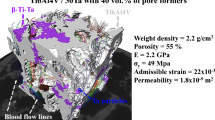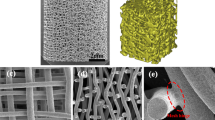Abstract
Bone replacement with conventional biomaterials entails a biomechanical incompatibility with respect to highly specialized and anisotropic bone tissue; stiffness mismatch is the most important example of that event, and it is always present in the components of all prosthetic systems for dental and joint replacements. In the case of titanium implants used for those biomedical applications, the main consequence of that mismatch is the bone resorption around the implants due to stress shielding with respect to bone. Bio-inspired design frameworks have opened a broad field of possibilities for new approaches to the stress-shielding phenomenon in bone replacements systems. To that end, conventional and non-conventional powder metallurgy have emerged as the feasible processing techniques for producing porous samples, which can match both complexity and anisotropy of bone tissue. Complete dental restoration is a good example of biomechanical systems with an important change of longitudinal stiffness once the components are implanted; therefore, development of new prosthetics systems with graded porosity for continuous Young’s modulus change is required. Samples with longitudinal graded porosity (symmetric and non-symmetric) by space-holder technique were developed, fabricated, and characterized in this work. Main findings indicated that the experimental procedure for space-holder elimination was effective, feasible, and reproducible, with better results for a compaction pressure of 800 MPa with low global NaCl content. Three-layer design (30/40/50) allowed stress shielding to be reduced without any important effect on mechanical strength with respect to the cortical bone.







Similar content being viewed by others

References
Currey J (1998) In: Black JH, Garth (eds) Handbook of Biomaterials Properties. Springer, London
Gibson LJ, Ashby MF (1997) Cellular Solids: Structure and Properties, 2nd edn. University Press, Cambridge
Yuhua L, Chao Y, Haidong Z, Shengguan Q, Xiaoqiang L, Yuanyuan L (2014) New developments of Ti-based alloys for biomedical applications (review). Materials 7:1709–1800
Oh IH, Nomura N, Hanada S (2002) Microstructures and mechanical properties of porous titanium compacts prepared by powder sintering. Mater Trans 43:443–446
Liang-jian CHEN, Ting LI, Yi-min LI, Hao HE, You-hua HU (2009) Porous titanium implants fabricated by metal injection molding. Trans Nonferrous Met Soc China 19:1174–1179
Li JC, Dunand DC (2011) Mechanical properties of directionally freeze-cast titanium foams. Acta Mater 59:146–158
Ibrahim A, Zhang F, Otterstein E, Burkel E (2011) Processing of porous Ti and Ti5Mn foams by spark plasma sintering. Mater Des 32:146–153
Xiong JY, Li YC, Wang XJ, Hodgson PD, Wen CE (2008) Titanium–nickel shape memory alloy foams for bone tissue engineering. J Mech Behav Biomed Mater 1:269–273
Esen Z, Bor S (2011) Characterization of Ti–6Al–4 V alloy foams synthesized by space holder technique. Mater Sci Eng A 528:3200–3209
Zhao X, Sun H, Lan L, Huang J, Zhang H, Wang Y (2009) Pore structures of high-porosity NiTi alloys made from elemental powders with NaCl temporary space-holders. Mater Lett 63:2402–2404
Niu W, Bai C, Qiu G, Wang Q (2009) Processing and properties of porous titanium using space holder technique. Mater Sci Eng A 506:148–151
Miao X, Sun D (2010) Graded/gradient porous biomaterials. Materials 3:26–47
Kato K, Ochiai S, Yamamoto A, Daigo Y, Honma K, Matano S, Omor K (2013) Novel multilayer Ti foam with cortical bone strength and cytocompatibility. Acta Biomater 9:5802–5809
Banhart J (2001) Manufacture, characterisation and application of cellular metals and metal foams. Prog Mater Sci 46:559–632
Torres Y, Pavón JJ, Nieto I, Rodríguez JA (2011) Conventional powder metallurgy process and characterization of porous titanium for biomedical applications. Metall Mater Trans B 42B:891–900
Torres Y, Pavón JJ, Rodríguez JA (2012) Processing and characterization of porous titanium for implants by using NaCl as space holder. J Mater Process Technol 212:1061–1069
Torres Y, Rodríguez JA, Arias S, Echeverry M, Robledo S, Amigo V, Pavón JJ (2012) Processing, characterization and biological testing of porous titanium obtained by space-holder technique. J Mater Sci 47(18):6565–6576. doi:10.1007/s10853-012-6586-9
Torres Y, Trueba P, Pavón JJ, Montealegre I, Rodríguez JA (2014) Designing, processing and characterisation of titanium cylinders with graded porosity: an alternative to stress-shielding solutions. Mater Des 63:316–324
ASTM F67-13 (2013) Standard specification for unalloyed titanium, for surgical implant applications (UNS R50250, UNS R50400, UNS R50550, UNS R50700)
ASTM E9-89a (2000) Standard test methods of compression testing of metallic materials at room temperature
ASTM C373-14 (2014) Standard test method for water absorption, bulk density, apparent porosity, and apparent specific gravity of fired whiteware products, ceramic tiles, and glass tiles
Traini T, Mangano C, Sammons RL, Mangano F, Macchi A, Piattelli A (2008) Direct laser metal sintering as a new approach to fabrication of an isoelastic functionally graded material for manufacture of porous titanium dental implants. Dent Mater 24:1525–1533
Acknowledgements
This work was supported by the Ministerio de Ciencia y Tecnología, MICINN (Spain) through the Project Ref. MAT2010-20855 and the Junta de Andalucía-FEDER (Spain) through the Project Ref. P12-TEP-1401. Furthermore, the authors wish to thank the students M. Sevilla and J.A. Ramos as well as the laboratory technicians J. Pinto and M. Sánchez for their assistance in microstructure characterization and mechanical testing.
Author information
Authors and Affiliations
Corresponding author
Rights and permissions
About this article
Cite this article
Pavón, J.J., Trueba, P., Rodríguez-Ortiz, J.A. et al. Development of new titanium implants with longitudinal gradient porosity by space-holder technique. J Mater Sci 50, 6103–6112 (2015). https://doi.org/10.1007/s10853-015-9163-1
Received:
Accepted:
Published:
Issue Date:
DOI: https://doi.org/10.1007/s10853-015-9163-1



